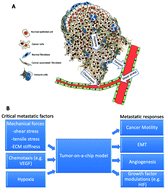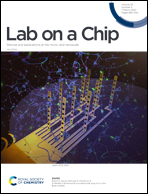Tumor-on-a-chip for integrating a 3D tumor microenvironment: chemical and mechanical factors
Abstract
Tumor progression, including metastasis, is significantly influenced by factors in the tumor microenvironment (TME) such as mechanical force, shear stress, chemotaxis, and hypoxia. At present, most cancer studies investigate tumor metastasis by conventional cell culture methods and animal models, which are limited in data interpretation. Although patient tissue analysis, such as human patient-derived xenografts (PDX), can provide important clinical relevant information, they may not be feasible for functional studies as they are costly and time-consuming. Thus, in vitro three-dimensional (3D) models are rapidly being developed that mimic TME and allow functional investigations of metastatic mechanisms and drug responses. One of those new 3D models is tumor-on-a-chip technology that provides a powerful in vitro platform for cancer research, with the ability to mimic the complex physiological architecture and precise spatiotemporal control. Tumor-on-a-chip technology can provide integrated features including 3D scaffolding, multicellular culture, and a vasculature system to simulate dynamic flow in vivo. Here, we review a select set of recent achievements in tumor-on-a-chip approaches and present potential directions for tumor-on-a-chip systems in the future for areas including mechanical and chemical mimetic systems. We also discuss challenges and perspectives in both biological factors and engineering methods for tumor-on-a-chip progress. These approaches will allow in the future for the tumor-on-a-chip systems to test therapeutic approaches for individuals through using their cancerous cells gathered through approaches like biopsies, which then will contribute toward personalized medicine treatments for improving their outcomes.

- This article is part of the themed collection: Organ-, body- and disease-on-a-chip systems


 Please wait while we load your content...
Please wait while we load your content...